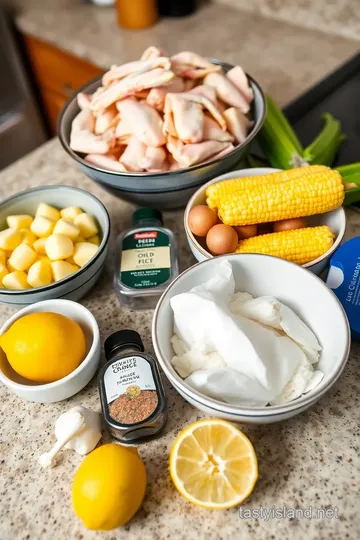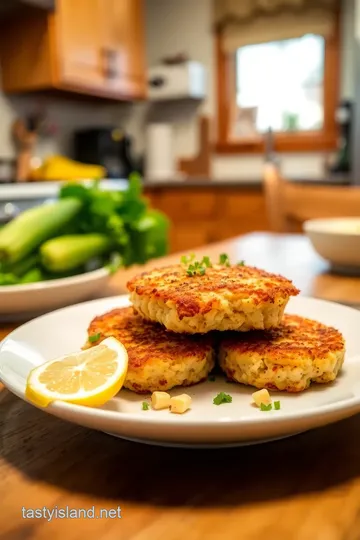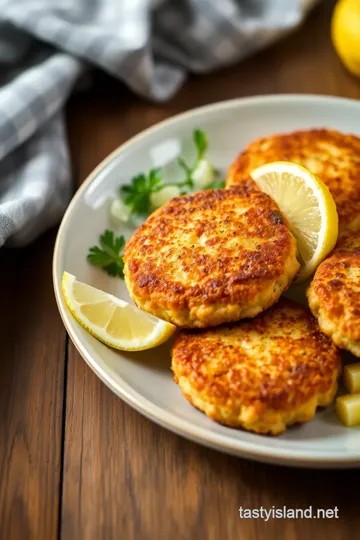Crispy Fried Crab Cakes with Spicy Kick
Have you ever tasted crispy fried crab cakes with a spicy kick? Inspired by coastal kitchens, this delightful recipe is a must-try for seafood lovers. Perfect for gatherings or a cozy dinner at home!

- Essential Ingredients Guide for Fried Crab Cakes with a Spicy Kick
- Mastering the Art of Fried Crab Cakes with a Spicy Kick
- Pro Tips & Secrets for Perfect Fried Crab Cakes
- Perfect Presentation for an Eye-Catching Dish
- Storage & Make-Ahead Magic
- Creative Variations That Wow
- Complete Nutrition Guide
- Expert FAQ Solutions
- Recipe Card
When i was a kid, my family took a road trip along the coast , and we stopped at this charming little seaside shack.
You know the kind—weathered wood, sandy floors, and a menu that read like a love letter to the ocean. i remember taking my first bite of a crab cake, and it was life-changing .
The crispiness outside combined with that tender, juicy lump crab meat inside? pure magic. fast forward to today, i’ve recreated that joy at home with these fried crab cakes with spicy kick .
Trust me; they're not your average seafood appetizer.
So, what's the deal with crab cakes, anyway? originating from the beautiful coastal regions of the united states, they've transformed from a simple crab cake recipe into a must-have dish at every summer bbq, holiday gathering, or fancy dinner party.
They are iconic! whether you call them cajun crab cakes or simply spicy crab cakes , one thing is clear—they are here to stay.
Plus, these babies are a bit of a showstopper, and they don’t require a culinary degree to whip up.
Recipe Overview
Fried crab cakes with spicy kick can be your new go-to dish. this easy crab cake recipe comes together in about an hour, give or take some chilling time.
Prep takes about 15 minutes , but seriously, let that mixture chill in the fridge for 30 minutes —it’s a game changer! the cook time is just 10– 15 minutes , depending on how crispy you want them.
The best part? you can whip up a batch of these scrumptious beauties for just around $20, yielding about eight perfectly crispy crab cakes .
Key Benefits
Now, let’s chat benefits. first off, they're packed with lump crab meat , which is not only delicious but loaded with lean protein and omega-3 fatty acids .
So yes, while they might be fried, they can also be part of a balanced meal. when you team them up with a zesty remoulade sauce or a tangy tartar sauce , you get a surf-and-turf vibe that’s all about indulgence without the guilt.
Make these for your next gathering, and everyone will be raving about your culinary skills.
Let’s not forget—they're perfect for special occasions! from casual get-togethers to formal parties, these spicy seafood dishes fit right in.
If you want to impress someone, cook up a batch and present them as part of a seafood party platter .
I mean, what’s more impressive than homemade crab cakes, right?
It’s easy to adapt this recipe, too. want a zesty twist? add diced jalapeños for an extra kick! the crab cake cooking time is short, and they’re so versatile.
You can make mini versions for party appetizers or slightly larger ones to serve as a stunning main dish. seriously, who doesn’t want crispy crab cakes sitting center stage on their dinner table?
From Mixture to Magic
So, you’re probably itching to see what goes into these marvelous creations. we’ll dive into the best crab cake ingredients soon, but before we get into that, let me tell you about the culinary techniques for frying .
Just remember: the secret to a perfectly shaped crab cake is chilling that mixture before cooking. feeling a bit adventurous? try chilling crab cake mixture overnight—you’ll thank me later!
When you’re ready, throw on that apron, and let’s make some finger-lickin’ good crab cakes! Your taste buds are about to go on a wild ride. Ready? Let’s grab those ingredients!

Essential Ingredients Guide for Fried Crab Cakes with a Spicy Kick
If you’re diving into the world of coastal cuisine, particularly those fried crab cakes with a spicy kick , there are a few things you need to get right first.
Trust me, it makes all the difference between a "meh" crab cake and one that makes everyone at your gathering go wow! so grab your apron, and let’s break it down!
Premium Core Components
Starting with the best crab cake ingredients , you’ll want to gather:
- 1 pound (450g) lump crab meat : Look for the freshest crab you can find; it’s the star of your dish!
- 1/2 cup (60g) panko breadcrumbs : These bad boys will give your cakes that ultimate crunch. You not only want any breadcrumbs; go for panko for that crispy texture!
- 1 large egg : This binds your crab cakes together and gives them a nice fluff.
- Mayonnaise : About 1/4 cup (60ml) will add creaminess. I recommend sticking to the real deal here, none of that low-fat nonsense.
Storage guidelines and shelf life : keep your crab meat refrigerated and use it within 1-2 days of purchase. once you've made those cakes, keep them in an airtight container to chill out in the fridge for up to 2 days.
Signature Seasoning Blend
You know what really makes these spicy crab cakes sing? The right seasonings . Here are the essentials:
- Old Bay seasoning : Just 1/2 teaspoon (2g) can add that coastal flavor. It’s practically the magic dust for seafood.
- Cayenne pepper : Adjust this with 1/2 teaspoon (2.5g) for a real kick . If you're feeling spicy , throw in some diced jalapeños too!
- Dijon mustard : This gives a tang that's refreshing and pairs beautifully with the crab.
Picking the right herbs is key too! Think parsley, dill, or even some chives.
Smart Substitutions
Life happens, and sometimes you don’t have everything in your pantry. Here are some quick and easy smart substitutions for when you’re in a pinch:
- No crab meat? Try using canned tuna or even shrimp; just make sure to chop it up nice and fine.
- Bread crumbs shortage? Crush some crackers or even cornmeal. It's all about getting creative!
And hey, if you're whipping up something healthy , consider using Greek yogurt instead of mayo. You'll still get that creaminess without the extra calories!
Kitchen Equipment Essentials
You don’t need a fancy setup to make homemade crab cakes shine. Here’s what you’ll want:
- Mixing bowls for blending goodies together
- A large skillet for frying; cast iron works best for even heat!
Preparation tips : Use a slotted spoon while frying so you don’t have to risk burning your hands. Safety first, my friends!
And don’t forget the chilling crab cake mixture . Pop it in the fridge for 30 minutes. This little step helps maintain their shape while you cook them up.
Closing Thoughts
Once you’ve gathered your ingredients and prepped everything, you’ll be ready to jump to the fun part—the cooking! imagine your friends' faces when they take that first bite of these crispy crab cakes .
It's all about that blend of flavors, textures, and just enough kick to keep you reaching for more. and trust me, you’ll want to have that remoulade sauce ready to go.
So, let’s get frying! Your next coastal dinner party is going to be a hit with these fried seafood recipes . Get your spatula, and let’s cook up some deliciousness.
Mastering the Art of Fried Crab Cakes with a Spicy Kick
If you’re looking to impress your friends or spice up a casual dinner, let me tell you, fried crab cakes with a spicy kick are the ultimate way to go! these golden-brown little wonders are packed with yummy lump crab meat and a zesty blend of spices.
You’ve got the sweetness of the crab and the boldness of spices dancing together, making them the perfect seafood appetizer or even a main dish.
Trust me, no one's going to complain when you serve these beauties!
Essential Preparation Steps
Before throwing everything into a bowl, let’s focus on the basics. first up, mise en place . french for “everything in its place,” it’s a fancy way of saying, “get your ducks in a row.
” so, lay out all your ingredients – trust me; it makes a world of difference when you're in the zone.
Next, time management. aim for about 15 minutes of active prep time, then 30 minutes of chilling. that’s right, chilling is key! it helps the mixture set, making it easier to shape into those coveted cakes.
And don’t forget organization strategies; keep your workspace clutter-free. it’s just more fun that way!
Oh, and safety! when you're frying, keep an eye on the oil. we’re heating it to about 350° f ( 175° c) – that’s hot! and if you splash any, make sure to clean it up right away to avoid any slip-ups.
Step-by-Step Process
Alright, let’s dive into the action! Here’s how to whip up those scrumptious cakes:
-
Prepare the mixture : in a bowl, combine 1 pound of lump crab meat, 1/2 cup of panko breadcrumbs, 1/4 cup mayo, 1 beaten egg, and other seasonings.
Mix gently. don’t go beatin’ those lumps to death!
-
Chill the mixture : once everything’s mixed up, cover that baby and toss it in the fridge for about 30 minutes .
This makes it easier to handle when you form the cakes.
-
Form the Cakes : Shape the chilled mixture into cakes, about 2 inches wide and 1 inch thick .
-
Heat the Oil : In a large skillet, get about 1 cup of vegetable oil shimmering over medium heat. You want it hot, but not smoking!
-
Fry the crab cakes : carefully place the cakes in the oil. you’re looking at about 4- 5 minutes per side.
If they’re nice and golden, you’re on the right track!
-
Drain and Serve : Scoop them out, place them on a paper towel to soak up the excess oil, and dig in!
Expert Techniques
Now, let’s get into some expert tips to really nail these crispy crab cakes . first off, make sure your key ingredient —the crab—is top-notch.
Good quality lump crab meat is essential; don't settle for imitation!
While cooking, keep a sharp eye on timing. under-frying could leave you with soggy cakes, while over-frying might make them dry.
You want that perfect, crispy outside. if it seems off, don’t hesitate to adjust your frying time.
Also, think about the seasonings! a pinch of old bay is classic, but don’t be shy to experiment. you want your spicy seafood dish to pack a punch, so adjust the cayenne pepper to your heat preference.
Success Strategies
We’ve all been there, right? You try a recipe and it just doesn’t turn out how you thought. Let's dodge those common mistakes!
For starters, always chill your mixture. if it feels too loose, toss in a tad more breadcrumbs to bind it.
That’ll prevent those tragedies where you’re left with crab-flavored mush in the frying pan.
The other thing? fry in batches! this maintains the heat of the oil, making sure every crab cake comes out golden and crispy.
Keeping them warm in a low oven while you cook the others can really help with timing too.
Plus, if you want to make ahead for a party, prep the mixture and shape the cakes a day prior. Just keep them buried in the fridge until you’re ready to fry.
Additional Information
So, there you have it! a simple yet oh-so-delicious way to treat your taste buds with fried crab cakes that kick! with a few expert techniques and a sprinkle of love, you can impress any crowd.
Keep this recipe in your back pocket for those summer cookouts or elegant dinner parties. and remember, the secret to the best fried crab cakes lies in quality ingredients and a healthy dose of patience.
Happy cooking!

Pro Tips & Secrets for Perfect Fried Crab Cakes
So, you’ve got your Fried Crab Cakes with Spicy Kick ready to rock! But wait, let's dive into some pro tips to take your crab cake game to the next level.
Start with quality ingredients: first off, grab lump crab meat that's fresh. the flavor is leagues ahead of imitation stuff.
Seriously, it makes all the difference! if you're at a seafood market, don't hesitate to ask for the best stuff.
Chill, don’t spill: after you mix everything, don’t skip chilling the crab cake mixture for at least 30 minutes .
It’s like a power-up! chilling helps everything stick together. nothing worse than a crab cake that falls apart in the pan.
Perfect frying techniques: speaking of frying, heat your oil to medium before adding those cakes. too hot and you’ll burn them.
Too cool, and they’ll soak up oil like a sponge. aim for a shimmering surface!
Season well: always taste your mixture before shaping it into cakes. adjust with a pinch of salt or more cayenne if you want a little extra kick .
And be generous with that old bay seasoning —it’s a game-changer!
Perfect Presentation for an Eye-Catching Dish
Okay, folks, presentation is where you can really wow your guests! When serving Fried Crab Cakes , let’s be real, you want people to do a double-take.
Plating for Success: For a fabulous presentation, stack two or three crispy crab cakes on a colorful plate. A splash of vibrant sauce, like a homemade remoulade or tartar sauce , can elevate your dish from basic to gourmet!
Garnish Genius: Fresh herbs are your best friends here. Chop some parsley or even chives for a sprinkle over the top. It’s like giving your dish a little cape!
Color and texture matters: think about pairing your crab cakes with something vibrant like a light salad or a slaw.
Those greens pop against the golden-brown cakes and make your dish tantalizingly appealing.
Storage & Make-Ahead Magic
Sometimes, life happens! If you need to make things ahead of time, I’ve got your back.
Refrigeration rules: first, keep those crab cakes in the fridge if you’ve prepped them. store them in an airtight container to keep them fresh.
They should last about two to three days .
Freezing for later: if you want to pause the party, freeze them! flash freeze for about an hour on a baking sheet, then transfer them to a freezer bag.
They’ll keep for up to three months . talk about easy seafood appetizers when you want them!
Creative Variations That Wow
Feeling a bit adventurous? Let’s shake things up with some delicious variations.
Spicy crab cake innovations: want more heat? toss in some diced jalapeños right into the mixture. it adds an unexpected burst of flavor.
Or, swap out the crab and try shrimp for a new take on this seafood dish .
Seasonal Inspired Additions: Don’t let seasons limit your creativity! Think about adding seasonal veggies—with summer squash in the mix, your cakes can sing with freshness!
Dietary tweaks: trying to keep it healthy? skip the mayo and go for greek yogurt. you won't even miss it.
Seriously, it lightens everything up, especially if you're making easy crab cakes for a cookout.
Complete Nutrition Guide
Let’s not forget about the good stuff your body needs! Each crab cake packs a punch with protein and essential nutrients.
Health perks: not only are these crab cakes delicious, but crab meat is rich in omega-3 fatty acids , which are fabulous for heart health.
Plus, they’re low in carbohydrates, making them a great choice for many diets.
Portion control: these cakes are filling but still lean, so if you're serving them as a party appetizer, one or two will do wonders! fret not about calories when you’ve got fresh crab cakes on the table.
Expert FAQ Solutions
Lastly, let’s tackle some common questions.
What if my cakes fall apart? If this happens, it might be that your mixture was too wet. Next time, add some panko breadcrumbs to thicken it up!
How do I know when they’re done? Well, when they’re golden brown and crispy on the outside, they’re ready to rock! Don’t rush the cooking time —it’s crucial for perfect texture.
In conclusion, making fried crab cakes with spicy kick isn’t just about the end product but also the journey! embrace the tips, get creative, and share them with your loved ones.
With these insights, you'll be making crowd-pleasing, elegant seafood dishes all year round. so chop, chill, and fry away! you've got this!

Crispy Fried Crab Cakes with Spicy Kick Card

⚖️ Ingredients:
- 1 pound lump crab meat, drained and picked over for shells
- 1/2 cup breadcrumbs (preferably panko for added crunch)
- 1/4 cup mayonnaise
- 1 large egg, beaten
- 2 tablespoons Dijon mustard
- 1 teaspoon Worcestershire sauce
- 1/2 teaspoon Old Bay seasoning
- 1/2 teaspoon cayenne pepper
- 1 tablespoon fresh parsley, chopped
- Salt and pepper to taste
- Vegetable oil for frying (approximately 1 cup)
🥄 Instructions:
- Step 1: In a mixing bowl, gently combine lump crab meat, breadcrumbs, mayonnaise, beaten egg, Dijon mustard, Worcestershire sauce, Old Bay seasoning, cayenne pepper, parsley, and seasoning.
- Step 2: Cover the bowl with plastic wrap and refrigerate for at least 30 minutes to firm up for easy shaping.
- Step 3: Once chilled, divide the mixture into equal portions and shape into cakes (approximately 2 inches wide and 1 inch thick).
- Step 4: In a skillet, heat vegetable oil over medium heat until shimmering.
- Step 5: Carefully place the crab cakes in the hot oil, frying in batches if necessary. Cook for about 4-5 minutes on each side or until golden brown and crispy.
- Step 6: Use a slotted spoon to remove crab cakes from the oil and place on a paper towel-lined plate to drain. Serve immediately.
Previous Recipe: How to Make the Best Mixing Fresh Red and Tasty Tomatoes Salad
Next Recipe: Ultimate Grilled Pineapple Skewers with Honey Glaze: A Delicious Summer Treat!
